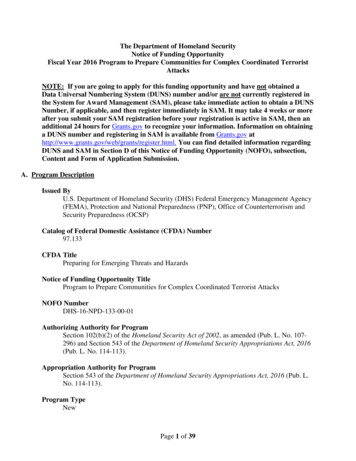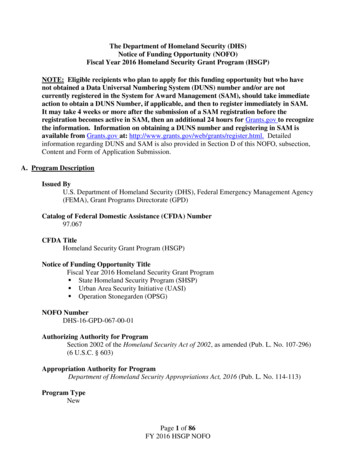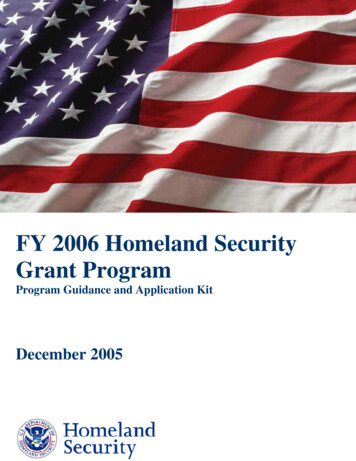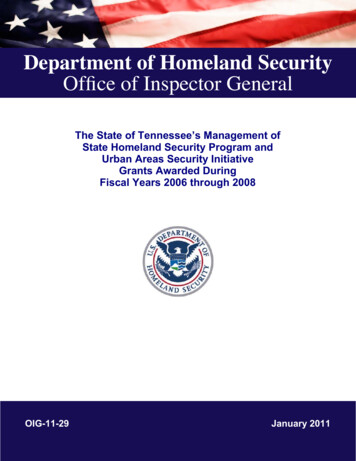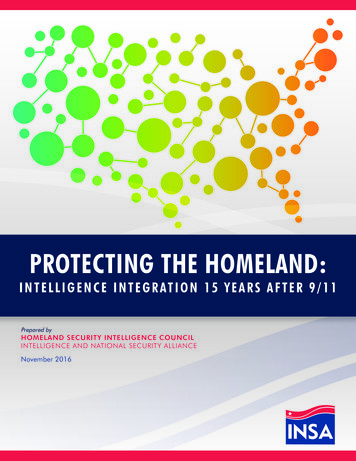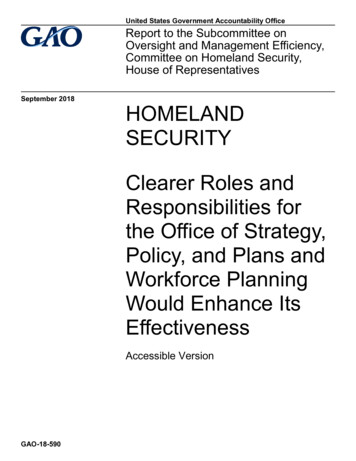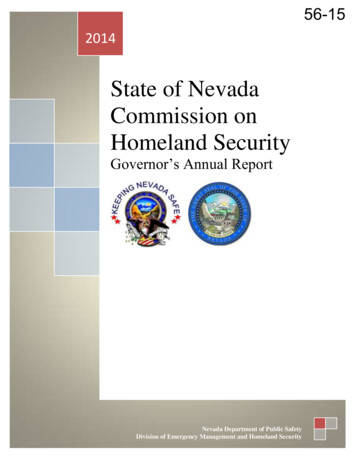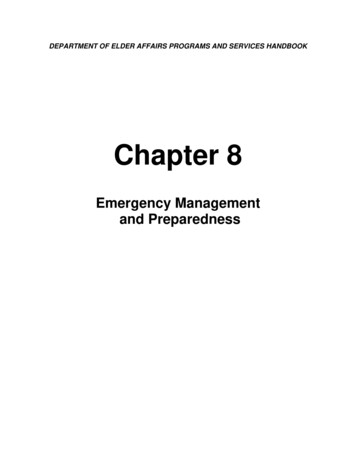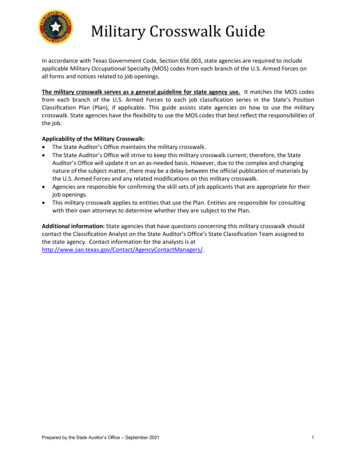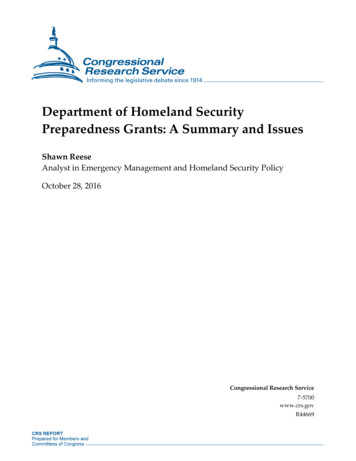
Transcription
Department of Homeland SecurityPreparedness Grants: A Summary and IssuesShawn ReeseAnalyst in Emergency Management and Homeland Security PolicyOctober 28, 2016Congressional Research Service7-5700www.crs.govR44669
Department of Homeland Security Preparedness Grants: A Summary and IssuesSummaryFollowing the September 11, 2001, terrorist attacks, Congress increased focus on state and localhomeland security assistance by, among other things, establishing the Department of HomelandSecurity (DHS) and authorizing DHS to administer federal homeland security grant programs.These homeland security grants have been administered by numerous DHS entities, and thesegrants have focused on such preparedness activities as assistance to states and localities to prepareand respond to terrorist attacks, securing critical infrastructure such as rail and ports, securingnonprofit (nongovernmental) organizations, and securing high-threat and high-risk urban areas.If homeland security continues to be of national interest, how homeland security assistance isfunded, administered, and allocated will be of importance to Congress. Since Congress wouldcontinue to conduct oversight and legislate on homeland security assistance to states andlocalities, Members may elect to consider policy options that anticipate, as well as react to, futurecatastrophes.Throughout the past 15 years, there has been a continued discussion on the number and purposeof the grant programs, state and locality use of grant program funding, and the funding amountsannually appropriated to the grant programs. All of these issues identify a potential need forCongress to continue its debate and consider legislation related to federal homeland securityassistance for states and localities and the nation’s overall emergency preparedness. One majorissue remains, and is comprised of these other issues, and that is whether or not these grants areeffective in assisting states and localities in meeting the national preparedness goals.Congressional Research Service
Department of Homeland Security Preparedness Grants: A Summary and IssuesContentsIntroduction . 1Historical Development of Federal Assistance . 2Summary of Grant Programs . 5Preparedness (Non-Disaster) Grant Programs . 5Emergency Management Performance Grant Program (EMPG). 5Homeland Security Grant Program (HSGP) . 5Intercity Bus Security Grant Program (IBSGP) . 6Intercity Passenger Rail Security—Amtrak Grant Program (IPR) . 7Nonprofit Security Grant Program (NSGP) . 7Port Security Grant Program (PSGP). 7Tribal Homeland Security Grant Program (THSGP) . 8Transit Security Grant Program (TSGP) . 8Eligible Grant Recipients . 8Overview of Grant Life Cycle and Appropriations Data . 9Issues for Congress . 10Purpose and Number of Assistance Programs . 10Evaluation of Funding Use. 11Funding Amounts . 13FiguresFigure 1. Historical Development of Homeland Security Assistance . 4Figure 2. Life Cycle of a Federal Grant . 9Figure 3. Total DHS Assistance for States and Localities, FY2002-FY2016. 14Figure 4. Individual DHS Assistance for States and Localities, FY2002-FY2016 . 15TablesTable 1.Eligible Recipients and Allocation Process, of FY2016 Homeland SecurityAssistance, by Program . 8Table 2. FY2002-FY2016 Appropriations for Homeland Security Assistance Programs . 16ContactsAuthor Contact Information . 17Congressional Research Service
Department of Homeland Security Preparedness Grants: A Summary and IssuesIntroductionCongress has enacted legislation and appropriated grant funding to states and localities forhomeland security purposes since 1996.1 One of the first programs to provide this type of fundingwas the Nunn-Lugar-Domenici Program which was established by Congress in the 1996Department of Defense Reauthorization Act2 and provided assistance to over 150 cities forbiological, chemical, and nuclear security. Providing homeland security assistance to states andlocalities was arguably spurred by the 1993 bombing of the World Trade Center in New York Cityand the 1995 bombing of the Alfred P. Murrah federal building in Oklahoma City. Following theSeptember 11, 2001, terrorist attacks, Congress increased focus on state and local homelandsecurity assistance by, among other things, establishing the Department of Homeland Security(DHS) and authorizing DHS to administer federal homeland security grant programs.3 This reportfocuses on the department’s homeland security assistance programs for states and localities, butnot the department as a whole.4With the increase of international and domestic terrorist threats and attacks against the UnitedStates following the end of the Cold War, and the termination of the old federal civil defenseprograms, a number of policy questions arose regarding homeland security assistance programs.The majority of these questions have not been completely addressed, even though Congress hasdebated and enacted legislation that provides homeland security assistance to states and localitiessince 1996.The number and purpose of programs, their administration, and funding levels have evolved overthe past 20 years. These programs are intended to enhance and maintain state, local, andnonfederal or nongovernmental entity5 homeland security and emergency managementcapabilities. These grants were administered by numerous offices and agencies and include the Office for Domestic Preparedness which was within the Border andTransportation Security Directorate;Office for State and Local Government Coordination and Preparedness whichwas within the Office of the Secretary;Office for Grants and Training which was within the Preparedness Directorate;andGrants Programs Directorate within the Federal Emergency Management Agency(FEMA).Over the course of DHS’s administration of the preparedness grant programs, the programs’eligible uses also evolved. Initially, DHS preparedness grant program funding could not be used1For the purpose of this report, homeland security assistance programs are defined as Department of HomelandSecurity (DHS) programs, or programs that were transferred to DHS, that provide funding to states, localities, tribes,and other entities for security purposes; however, public safety and National Guard programs and funding are notincluded in this report. Additionally, the term “homeland security program” was not used until 2002. Prior to this, theterm “domestic preparedness” was used to describe programs and activities that assisted states and localities to preparefor possible terrorist attacks.2P.L. 104-106.3P.L. 107-296.4For information on DHS and its most recent appropriations, see CRS Report R44053, Department of HomelandSecurity Appropriations: FY2016, coordinated by William L. Painter.5Nonfederal and nongovernmental entities include grant recipients such as privately owned ports and transit systems,and nonprofit organizations.Congressional Research Service1
Department of Homeland Security Preparedness Grants: A Summary and Issuesfor state and local law enforcement personnel costs such as overtime, but for the past couple offiscal years, states and localities can fund law enforcement personnel overtime using this money.This guidance change is a combination of DHS’s evaluation of risks and threats and at the requestof states and localities. The ‘high-water’ amount of funding peaked in approximately FY2009,with the following fiscal years seeing a slight but consistent decline in program funding that maybe attributed to the policy concept of only needing to maintain previously established state andlocal homeland security capabilities.This report provides a brief summary of the development of DHS’s role in providing homelandsecurity assistance, a summary of the current homeland security programs managed by DHS, anda discussion of the following policy questions: (1) the purpose and number of programs; (2) theuse of homeland security assistance program funding; and (3) the funding amounts for theprograms.List of Pertinent Acronyms1. Nunn-Lugar-Domenici Program (NLD)2. Office for Domestic Preparedness (ODP)3. Grants Program Directorate (GPD)4. Emergency Management Performance Grant Program (EMPG)5. Homeland Security Grant Program (HSGP)6. State Homeland Security Grant Program (SHSP)7. Urban Area Security Initiative (UASI)8. Operation Stonegarden (OPSG)9. Intercity Bus Security Grant Program (IBSGP)10. Intercity Passenger Rail Security—Amtrak Grant Program (IPR)11. Port Security Grant Program (PSGP)12. Tribal Homeland Security Grant Program (THSGP)13. Transit Security Grant Program (TSGP)Historical Development of Federal AssistanceIn 1996, Congress enacted the Defense Against Weapons of Mass Destruction Act (known as theNunn-Lugar-Domenici Act). This law, among other things, established the Nunn-Lugar-DomeniciProgram (NLD) and was intended to provide financial assistance to major U.S. metropolitanstatistical areas. This assistance, with the Oklahoma City bombing being the primary catalyst, wasfocused on assisting first responders to prepare for, prevent, and respond to terrorist attacksinvolving weapons of mass destruction.6 Initially, the Department of Defense (DOD) wasresponsible for administering NLD, but, in 1998, NLD was transferred to the Department ofJustice (DOJ) which then established the Office of Domestic Preparedness (ODP) to administerNLD, and other activities that enhanced state and local emergency response capabilities.7 Initially,forty cities had received funding by 1998, and by 2001, 120 cities had received assistance. The6P.L. 104-201, Title XIV, Subtitle A, Sec. 1412, 110 Stat. 2718.U.S. Department of Justice, Office for Domestic Preparedness, “Emergency Responder Guidelines,” Washington, DC,August 2002, p. 1, 7Congressional Research Service2
Department of Homeland Security Preparedness Grants: A Summary and IssuesNLD ended in 2001 with a total of 157 cities receiving training and funding for personalprotective equipment.8ODP was transferred to DHS with enactment of the Homeland Security Act of 2002.9 Initially,ODP and its terrorism preparedness programs were administered by the Border andTransportation Security Directorate, and all-hazard preparedness programs were in the FederalEmergency Management Agency (FEMA). ODP and all preparedness assistance programs weretransferred to the Office of the Secretary in DHS in 2004. After investigations into theproblematic response to Hurricane Katrina, the programs were transferred to the NationalPreparedness Directorate. Currently all programs and activities are administered by the GrantsProgram Directorate (GPD) within FEMA. Figure 1 provides a graphical representation of thehistorical development of the administration of federal homeland security assistance from 1996 topresent.8James Martin Center for Nonproliferation Studies, Nunn-Lugar-Domenici Domestic Preparedness and WMD CivilSupport Teams, Monterey, CA, October 2001, http://cns.miis.edu/research/cbw/120city.htm.9P.L. 107-296, Title IV, Sec. 403, 116 Stat. 2178.Congressional Research Service3
Department of Homeland Security Preparedness Grants: A Summary and IssuesFigure 1. Historical Development of Homeland Security AssistanceSource: CRS analysis of the evolution of DHS grants administration.Since the establishment of DHS, the department has not only been responsible for preparing forand responding to terrorist attacks, it is also the lead agency for preparing for, responding to, andrecovering from any accidental man-made or natural disasters. P.L. 110-53, ImplementingCongressional Research Service4
Department of Homeland Security Preparedness Grants: A Summary and IssuesRecommendations of the 9/11 Commission Act of 2007, authorized a number of the DHS grantsand mandated some of their allocation methodologies. This legislation was a result of numerousyears of debate on how DHS should allocate homeland security assistance funding to states, theDistrict of Columbia, and U.S. insular areas.10Summary of Grant ProgramsIn FY2003, DHS administered 8 homeland security grant programs, and there are now 10 inFY2016. DHS administered as many as 15 programs in FY2010. The following sectionsummarizes the 10 programs and activities that are currently administered by DHS. This reportuses DHS documents to summarize the programs. This report is not intended to provide in-depthinformation on these grants. For detailed information on individual grant programs, see the citedsources.Preparedness (Non-Disaster) Grant ProgramsAll 10 programs administered by FEMA’s Grants Program Directorate (GPD) are preparedness(non-disaster) grants. These programs specifically “provide state and local governments withpreparedness program funding in the form of non-disaster grants to enhance the capacity of stateand local emergency responders to prevent, respond to, and recover from a weapons of massdestruction terrorism incident involving chemical, biological, radiological, nuclear, explosivedevices, and cyber-attacks.”11Emergency Management Performance Grant Program (EMPG)12EMPG is intended to provide federal funds to states to assist state, local, territorial, and tribalgovernments in preparing for all hazards. These funds are to provide a system of emergencypreparedness for the “protection of life and property in the United States from hazards and to vestresponsibility for emergency preparedness jointly in the Federal Government, states, and theirpolitical subdivisions.”13 The EMPG’s priority is to support the implementation of the NationalPreparedness System.14Homeland Security Grant Program (HSGP)15HSGP supports state and local activities to prevent terrorism and other catastrophic events and toprepare for threats and hazards that pose the “greatest” risk to the nation’s security. HSGP is10U.S. insular areas include Puerto Rico, Northern Mariana Islands, U.S. Virgin Islands, Guam, and American er-grants.12Authorized by 6 U.S.C. §762, and 42 U.S.C. §5121 et seq.13U.S. Department of Homeland Security, Emergency Management Performance Grant Program Multi-YearProgrammatic Guidance, Federal Emergency Management Agency, Washington, DC, 2016, p. 1. Available 5293-190ed88e1b63940c87121a3f0b97b8a5/EMPG Multi Year Program Guidance Final.pdf.14For more information on the National Preparedness System, see CRS Report R42073, Presidential Policy Directive 8and the National Preparedness System: Background and Issues for Congress, by Jared T. Brown.15Authorized by 6 U.S.C. §603.11Congressional Research Service5
Department of Homeland Security Preparedness Grants: A Summary and Issuescomprised of three grant programs—State Homeland Security Grant Program (SHSP), UrbanArea Security Initiative (UASI), and Operation Stonegarden (OPSG).16SHSPSHSP assists state, tribal, and local governments with preparedness activities that address highpriority preparedness gaps across all preparedness core capabilities where a nexus to terrorismexists. Jurisdictions need core capabilities that are “flexible” and determine how to applyresources to prepare to respond to specific threats to specific jurisdictions. Communities needpreparedness capabilities to prevent, protect against, mitigate, respond to, and recover fromthreats and hazards that pose the greatest risk.17All federal investments are based on capabilitytargets and gaps identified during the Threat and Hazard Identification and Risk Assessment(THIRA) process, and assessed in the State Preparedness Report (SPR).18 THIRA is a four-stepcommon risk assessment process that assists individuals, businesses, faith-based organizations,nonprofit groups, schools and academia, and all levels of government to understand its risks andestimate capability requirements.19 SPR is a self-assessment of a jurisdiction’s current capabilitylevels against the capability targets identified in its THIRA.20UASIUASI assists high-threat, high-density urban areas to build and sustain the capabilities necessaryto prevent, protect against, mitigate, respond to, and recover from terrorist attacks.21 FederalUASI investments are based on UASI recipients’ THIRA.OPSGOPSG supports enhanced cooperation and coordination among Customs and Border Protection(CBP), U.S. Border Patrol (USBP), and local, tribal, territorial, state, and federal law enforcementagencies. OPSG provides funding for investments in joint efforts to secure the nation’s bordersalong routes of ingress from international borders to include travel corridors in states borderingMexico and Canada, as well as states and territories with international water borders.22Intercity Bus Security Grant Program (IBSGP)23IBSGP supports transportation infrastructure security activities that strengthen against risksassociated with potential terrorist attacks. Federal funding for IBSGP supports criticalinfrastructure hardening and other physical security enhancements to intercity bus operatorsserving the nation’s highest-risk metropolitan areas.2416U.S. Department of Homeland Security, Fiscal Year 2016 Homeland Security Grant Program, Washington, DC,2016, 18-3daa3552913b8affe0c6b5bc3b448635/FY 2016 HSGP NOFO -target-id.21Ibid.22Ibid.23Authorized by 6 U.S.C. §1182.24U.S. Department of Homeland Security, Fiscal Year 2016 Intercity Bus Security Grant Program, Washington, DC,(continued.)Congressional Research Service6
Department of Homeland Security Preparedness Grants: A Summary and IssuesIntercity Passenger Rail Security—Amtrak Grant Program (IPR)25IPR supports the nation’s rail system by providing funds for activities that prevent, protectagainst, mitigate, respond to, and recover from terrorist attacks. Examples of this support arebuilding and sustaining emergency management capabilities, protection of high-risk and highconsequence underwater and underground rail assets, and emergency preparedness drills andexercises.26Nonprofit Security Grant Program (NSGP)27NSGP provides funding support for target hardening and other physical security enhancements tonon-profit organizations that are at high risk of a terrorist attack and located within one of theFY2015 UASI-designated urban areas. The program intends to promote emergency preparednesscoordination and collaboration activities between public and private community representativesas well as state and local government agencies.28Port Security Grant Program (PSGP)29PSGP supports efforts to build and sustain National Preparedness Goal30 core capabilities acrossthe Goal’s mission areas, with specific focus on addressing the nation’s maritime ports’ securityneeds. The PSGP’s objectives are enhancing maritime domain awareness;enhancing Improvised Explosive Device (IED) and Chemical, Biological,Radiological, Nuclear, and Explosive (CBRNE) prevention, protection, response,and supporting recovery capabilities within the maritime domain;enhancing cybersecurity capabilities;supporting maritime security risk mitigation projects;supporting maritime preparedness training and exercises; andimplementing the Transportation Worker Identification Credential (TWIC).31(.continued)2016, pp. 1-2, 69-69b38a5e2b50a868885ed3a3aa44c269/FY 2016 IBSGP NOFO.pdf.25Authorized by 6 U.S.C. §1163.26U.S. Department of Homeland Security, Fiscal Year 2016 Intercity Passenger Rail, Washing, DC, 3274676-c6662c190a6db6a280e4b682df595514/FY 2016 IPR NOFO.pdf27Authorized by 6 U.S.C. §604.28U.S. Department of Homeland Security, Fiscal Year 2016 Non-Profit Security Grant Program, Washington, DC,2016, p. 2, 36-23a7f47d5eb078da9a57c444eef5bf6f/FY 2016 NSGP NOFO.pdf.29Authorized by 46 U.S.C. ss-goal.31U.S. Department of Homeland Security, Fiscal Year 2016 Port Security Grant Program, Washington, DC, 2016, p.2, 36-07ce03a778118ecc2ead8e1aae84185e/FY 2016 PSGP NOFO FINAL.pdf.Congressional Research Service7
Department of Homeland Security Preparedness Grants: A Summary and IssuesTribal Homeland Security Grant Program (THSGP)32THSGP funds are intended to increase U.S. native tribal abilities to prevent, prepare for, protectagainst, and respond to acts of terrorism. Some objectives of THSGP include advancing a wholecommunity approach to security and emergency preparedness, and strengthening cooperation andcoordination among local, regional, and state preparedness partners.33Transit Security Grant Program (TSGP)34TSGP directly support transportation infrastructure security activities. The program providesfunds to owners and operators of transit systems—including intra-city bus, commuter bus, ferries,and all forms of passenger rail—to protect critical surface transportation infrastructure and thetraveling public from acts of terrorism and to increase the resilience of transit infrastructure.35Eligible Grant RecipientsEach of the grant programs summarized above has different eligible recipients and processes thatdetermine allocations. The following table provides information on these 10 grant programs.Table 1.Eligible Recipients and Allocation Process, of FY2016 Homeland SecurityAssistance, by ProgramProgramEligible RecipientsAllocation ProcessEMPGstates, DC, Puerto Rico, and U.S.insular areasallocation formula mandated byCongressSHSPstates, DC, Puerto Rico, and U.S.insular areasallocation formula mandated byCongressUASIhigh-threat, high-risk urban areasdetermined by DHS through a riskassessmentOPSGinternational land and water borderstates, localities, and tribesdetermined by U.S. Customs andBorder Protection sector-specificborder risk methodologyIBSGowners and operators of fixed-routeintercity and charter buses servingUASI jurisdictionsdetermined by DHS through a riskassessmentIPRThe National Passenger RailroadCorporation (Amtrak)determined by DHS through a riskassessment of Amtrakroutes/stations in UASI jurisdictionsHSGP32Authorized by 6 U.S.C. §606.U.S. Department of Homeland Security, FY 2016 Tribal Homeland Security Grant Program (THSGP), Washington,DC, 2016, p. 2, 33-97bc5a9e7780bf31d19a3bdb76a12699/FY 2016 THSGP NOFO FINAL.pdf.34Authorized by 6 U.S.C. §1135.35U.S. Department of Homeland Security, Fiscal Year 2016 Transit Security Grant Program, Washington, DC, 2016,p. 1, 26-a6ed21fef27d60aa6ae2a8048c6f4682/FY 2016 TSGP NOFO.pdf.33Congressional Research Service8
Department of Homeland Security Preparedness Grants: A Summary and IssuesProgramEligible RecipientsAllocation ProcessNSGP501(c)(3) nonprofit organizationsdetermined by DHS Secretarythrough a risk assessment ofnonprofits in UASI jurisdictionsPSGPowners and operators of portfacilities and ferries, and state andlocal government entities responsiblefor port securitycompetitive review process by DHSTHSGP“Indian Tribe” defined by 6 U.S.C.§601(4)determined by DHS through a riskassessment and peer reviewTSGPstate, local, and privately ownedtransit agencies in UASI jurisdictionsdetermined by DHS through a riskassessment and competitive processSource: CRS review of U.S. Department of Homeland Security, Federal Emergency Management Agency,“Preparedness (Non-Disaster) Grants,” available at nts.Overview of Grant Life Cycle and AppropriationsDataGenerally, DHS grants follow the grant life cycle shown below in Figure 2. The life cycle of afederal grant traditionally includes four stages: pre-award, grant award, grant programadministration, and post-award audit. Figures 3 and 4 provide information on appropriations forDHS grant programs from FY2002 to FY2016.Figure 2. Life Cycle of a Federal GrantSource: CRS Report R42769, Federal Grants-in-Aid Administration: A Primer, by Natalie Keegan.This grant life cycle is how most federal grants are administered, applied for, and allocated. DHSgrants follow this grant life cycle.Congressional Research Service9
Department of Homeland Security Preparedness Grants: A Summary and IssuesIssues for CongressMore than 15 years after the terrorist attacks on September 11, 2001, and approximately 13 yearssince the establishment of DHS, debate continues on policy questions related to homelandsecurity assistance for states and localities. Some of these questions arguably have been addressedin legislation, such as the statute that modified the distribution of funding to states and localities(P.L. 110-53). Some may contend there is a need for the Congress to conduct further oversighthearings and legislate on policy issues related to DHS assistance to states and localities. Thesepotential issues include (1) the purpose and number of assistance programs; (2) the use of grantfunding; and (3) the funding level for the grant programs. The following analysis of these issuesprovides background for this policy discussion.Purpose and Number of Assistance ProgramsGenerally, each grant program has a range of eligible activities. When Congress authorizes afederal grant program, the eligible activities may be broad or specific depending on the statutorylanguage in the grant authorization. When grant funds are distributed through a competitiveprocess, the administering federal agency officials exercise discretion in the selection of grantprojects to be awarded funding within the range of eligible activities set forth by Congress.36Some may argue the purpose and number of DHS grant programs have not been sufficientlyaddressed. Specifically, should DHS provide more all-hazards assistance versus terrorism-focusedassistance? Does the number of individual grant programs result in coordination challenges anddeficient preparedness at the state and local level? Would program consolidation improvedomestic security? Finally, does the purpose and number of assistance programs affect theadministration of the grants?An all-hazards assistance program allows recipients to obligate and fund activities to prepare for,respond to, and recover from almost any emergency regardless of type or reason, which includesman-made (accidental or intentional) and natural disasters. EMPG is an example of an all-hazardsassistance program. Terrorism preparedness-focused programs allow recipients to obligate andfund activities to prepare for, respond to, and recover from terrorist incidents. SHSG is anexample of a terrorism preparedness-focused program.The majority of disasters and emergencies that have occurred since September 11, 2001, havebeen natural disasters from everyday floods and tornadoes, to major incidents such as HurricaneKatrina. However, the majority of homeland security assistance funding to states and localitieshas been appropriated to programs dedicated to preparing for and responding to terrorist attacks.A DHS fact sheet regarding Homeland Security Presidential Directive 837 states that federalpreparedness assistance is intended primarily to support state and local efforts to build capacity toaddress major (or catastrophic) events, especially terrorism.38In July 2005, the Government Accountability Office (GAO) stated that emergency responsecapabilities for terrorism, as well as man-made and natural disasters, are similar for response and36CRS Report R42769, Federal Grants-in-Aid Administration: A Primer, by Natalie Keegan.Executive Office of the President, Office of the Press Secretary, “Homeland Security Presidential Directive 8:National Preparedness,” press release, December 17, 2003, 031217-6.html.38U.S. Department of Homeland Security, Frequently Asked Questions: HSPD 8, Fact Sheet, Washington, DC, 2008,http://www.ojp.usdoj.go
These homeland security grants have been administered by numerous DHS entities, and these grants have focused on such preparedness activities as assistance to states and localities to prepare and respond to terrorist attacks, securing critical infrastructure such as rail and ports, securing nonprofit (nongovernmental) organizations, and .

